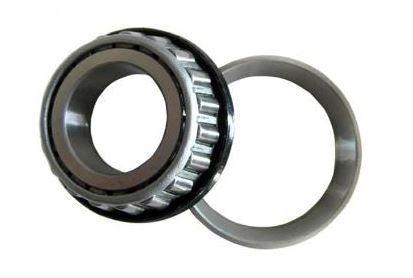Tapered roller bearings mainly bear radial and axial combined loads. Bearing capacity depends on the raceway angle of the outer ring. The larger the angle, the larger the bearing capacity. This type of bearing is a separate bearing, which is divided into single, double and four-row tapered roller bearings according to the number of rows of rolling elements in the bearing. The clearance of single-row tapered roller bearings needs to be adjusted by the user during installation; the clearances of double-row and four-row tapered roller bearings have been given according to user requirements when the product leaves the factory, and do not need to be adjusted by the user.
Tapered roller bearings have tapered inner and outer ring raceways with tapered rollers arranged between them. The projection lines of all conical surfaces converge at the same point on the bearing axis. This design makes tapered roller bearings particularly suitable for bearing combined (radial and axial) loads. The axial load capacity of a bearing is mostly determined by the contact angle α; the larger the angle α, the higher the axial load capacity. The angle is represented by the calculation coefficient e; the larger the value of e, the larger the contact angle, and the greater the applicability of the bearing to the axial load.
Tapered roller bearings are usually separated, that is, a tapered inner ring assembly composed of an inner ring with a roller and a cage assembly can be installed separately from the tapered outer ring (outer ring).
Tapered roller bearings are widely used in automobiles, rolling mills, mining, metallurgy, plastic machinery, and other industries.
The secondary reason for the tapered roller bearing to be scarred during the installation process is that the bearing is in the process of assembly and assembly, and the inner ring and the outer ring are skewed.
When the tapered roller bearing is being installed, it must be stopped in accordance with the working specifications, or many achievements will not be formed. If the form or method of the device is not proper, the bearing's raceway surface and the bone surface will form a linear wound on the bearing. The device of deep groove ball bearing indirectly reflects the precision, longevity, and function of the bearing in operation.

Although the quality of tapered roller bearings and other aspects are relatively good, rolling bearings are precision components, and their use must be carried out accordingly. No matter how high-performance bearings are used, if they are not used properly, they will not get the expected high performance. There are several notes on the use of bearings:
(1) Keep tapered roller bearings and their surroundings clean.
Even small dust that cannot be seen by the eyes can have a bad effect on the bearings. Therefore, keep the surroundings clean so that dust does not enter the bearings.
(2) Use with care.
The tapered roller bearing is strongly impacted during use, which may cause scars and indentations, which may cause accidents. In severe cases, cracks and breaks may occur, so care must be taken.
(3) Use appropriate operating tools.
Avoid replacing with existing tools, you must use the right tools.
(4) Pay attention to the corrosion of tapered roller bearings.
When operating the bearings, sweat from your hands can cause rust. Pay attention to the operation with clean hands, it is best to wear gloves as much as possible.
Tapered roller bearings use hearing to identify irregular operations. It is a very common method. For example, an electronic stethoscope is used by experienced operators to detect abnormal noise of a part. If the bearing is in a good operating condition, it will emit a low whining sound. If it emits a sharp hissing tapered roller bearing, squeaking, and other irregular sounds, it usually indicates that the bearing is in a bad operating condition.
1. Corrosion on tile surface: Abnormal concentration of non-ferrous metal elements was found by spectral analysis; many sub-micron-level wear particles of non-ferrous metal components appeared in the iron spectrum; lubricant moisture exceeded the standard and acid value exceeded the standard.
2. Journal surface strain: There are iron-based cutting abrasive particles or black oxide particles in the iron spectrum, and the metal surface has a tempered color.
3. Corrosion of journal surface: Spectral analysis found that the concentration of iron element is abnormal, there are many submicron particles with iron components in the iron spectrum, the lubricant water exceeds the standard or the acid value exceeds the standard.
4. Surface strain: Cutting abrasive grains are found in the iron spectrum, and the composition of the abrasive grains is a non-ferrous metal.
5. Fretting wear of tile back: spectrum analysis found that the iron concentration was abnormal, there were many iron particles with submicron wear particles in the iron spectrum, and the water content and acid value of the lubricant were abnormal.
Under the condition of liquid lubrication, the sliding surface is separated by the lubricating oil without direct contact, which can also greatly reduce friction loss and surface wear, and the oil film also has a certain ability to absorb vibration.
Sharp squeaking noise may be caused by improper lubrication. Improper bearing clearances can also cause metallic noise. The indentation on the track of the outer ring of the tapered roller bearing will cause vibration and cause a smooth and crisp sound. If it is caused by knocking damage during installation, the noise will also be generated. This noise will vary with the speed of the bearing. If there is intermittent noise, it means that the rolling elements may be damaged. This sound of tapered roller bearings occurs when the damaged surface is rolled. If there is contamination in the bearing, it will often cause hiss, and serious bearing damage will cause Generates irregular and loud noise.

